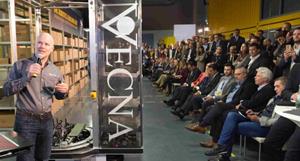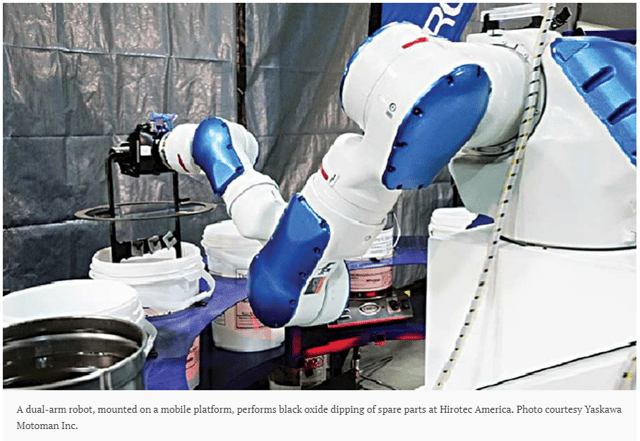What's New In Robotics This Week - Dec 15

Posted on Dec 15, 2017 7:00 AM. 14 min read time
-Manufacturing & Cobot Roundup
-Japan Firm Announces 2020 Moon Mission
-Gecko-Inspired Adhesion Tech
-Controversial HRIs in San Fran
...and much more!
Manufacturing & Cobot Roundup
Industrial robot and cobot maker ABB opened its first-ever 'Robotics Center' in Romania this week on the campus of the Politehnica University of Bucharest.
Business Review reports:
ABB Romania will use the training center for future projects and to practice new applications, as well as for various demonstrations dedicated to company customers. In all these projects the Machine and Manufacturing Systems Department of the Faculty of Engineering and Management of Technological Systems will be ABB’s partner to develop new themes, projects and solutions.
ABB has an installed base of [...] over 900 industrial robots in Romania alone.
FANUC system integrator Farason Corporation has created a system that can handle 50 cosmetics bottles per minute...
Pepperl+Fuchs has developed a system that improves intelligent detection and segmentation of objects. The software and vision sensors detect objects of varying shapes, colors, and surfaces, and compare the profile to a library of CAD data. Using this information, grip points are calculated and sent to a robot, along with movement instructions...
Cobots are among the "most useful" robots for small and medium-sized enterprises, says Automation:
Most collaborative robots are manufactured with an in-built safety-rated monitored stop, meaning that it will not move if a human is detected in its space. Speed and separation monitoring allow the robot to continue moving in the same space as the human, but if the distance is reduced to less than a set threshold, the robot will stop.
Vecna Robotics won the DHL & Dell Robotics Innovation Challenge 2017 in Germany.

CAPTION: Daniel Theobald, co-founder and chief innovation officer of Vecna Robotics, presents at DHL & Dell Robotics Innovation Challenge 2017 (Credit: Vecna)
The challenge required a mobile robot capable of navigating traditional warehouse shelves, and picking boxes and totes. Vecna Robotics’ Tote Retrieval System was not only able to successfully pick the boxes from different levels of the shelf but also was able to place the boxes and totes on its autonomous RC20 Conveyer (20kg) mobile robot.
DRS Industrial Robotics tested a GoPro mounted on a robotic CNC Router, with impressive results...
The UK's 'Startups' website predicts that the "cobot revolution" will be a major technology trend of 2018:
There is a growing realisation that, however advanced, robots cannot emulate the human touch: empathy, creativity, but they can work in tandem with humans to turbocharge productivity. [...] For small businesses, cobots also provide a much more realistic option – in terms of logistics. Replacing the more traditional industry robots, cobots are small, light and easy (if slow) to move – a stark contrast to their bulky, often immobile and extremely complicated predecessors.
UK-based Dudley Industries is using automation to increase production, replace human labour during the finishing process, and ensure consistent product quality.

Via Production Engineering Solutions:
As very high levels of demand for a recently introduced product began to place a considerable strain on the company’s existing fabrication finishing and weld dressing resources, a search was made for a solution to the company’s finishing bottlenecks. The answer was found in a new, fabrication finishing and weld dressing robotic cell, designed and manufactured by Autopulit and installed by Ellesco.
Members of the first graduating class of Rockewell Automation's Academy of Advanced Manufacturing shared their perspectives on the challenges facing U.S. military veterans aspiring to succeed in advanced manufacturing technology environments...
Welding equipment supplier Hirotec America is using automation to edge closer to lights out manufacturing, Assembly Magazine reports:

The robot, an SDA20D from Yaskawa Motoman Inc., is a dual-arm, 15-axis robot designed for complex assembly and material handling applications, including part transfer, machine tending, and pressing or forming. Each arm has a 20-kilogram payload capacity, and a horizontal and vertical reach of 910 millimeters.
The Manufacturer looked at the technologies that are transforming manufacturing and paving the way for Industry 4.0...
China's production of industrial robots exceeded 100,000 in the first ten months of this year, up 70 percent year on year, according to the Ministry of Industry and Information Technology. Overall output for 2017 is expected to surpass 120,000.
Via Xinhua:
The market volume of China's industrial robots is expected to reach 4.2 billion U.S. dollars in 2017 and increase to 5.9 billion dollars in 2020.
The robot industry has been listed as a key development area in the country's "Made in China 2025" strategy, which aims to upgrade the country's manufacturing sector.
Also in Xinhua, an interesting story about how the local district government in south China's Guangdong Province --home to manufacturing brands like Midea-- plans to build more than 30,000 apartments to be sold or rented at low prices in the next five years in an efort to retain robotics and IT talent.
"High-end talent is key to our industrial upgrading," said Huang Hai with the district government.
In September, the first real estate project was launched to offer 1,320 affordable apartments to qualified talent. The price was set at 9,800 yuan (1,500 U.S. dollars) per square meter, while the average market price in the neighborhood was 20,000 yuan per square meter.
For in-depth analysis of China's staggering automation numbers, make sure to check out Asian Robotics Review's "China's Automation Express":
When it comes to automation, it’s getting more and more like Outlook Asia 2018 is really Outlook China 2018 in almost everything, especially robots.
China is buying on the order of 9,000-plus industrial robots a month for 2017 (more than the total for the U.S. and EU combined), up from 7,000-plus a month in 2016, and forecast to skyrocket by a 140 percent by 2019.
Meanwhile, in Indonesia, manufacturers are turning to robots due to minimum wage increases in the region. And in the US, Vox explored the role of apprenticeships could play in shaping the future manufacturing workforce...
Elsewhere, Quantum Technology Supersensors won 'Breakthrough of the Year' at the Business Green Technology Awards for its smart material pressure sensors; switching from single to dual grippers enabled a Danish firm to cut cycle time almost in half, says Modern Materials Handling; and Canadian robotics firm Eclipse Automation has opened a new facility in Mesa, Arizona.
Japanese Firm Announces 2020 Moon Mission
Japanese startup and Google X Prize entrant, Ispace, has anounced plans to land a rover on the moon's surface by 2020. The firm also announced that it raised US$90.2m in its latest round of funding.

Caption: Concept image of ispace's Mission 1 lunar orbiter © ispace
TechInAsia reports:
Hakamada’s crew is busy prepping for its December 28 launch, when it’ll hitch a ride aboard a rocket launched by India’s Team Indus, an XPrize rival that has a moon rover of its own.
After that, the Japanese startup becomes a moon prospecting company – it has planned out a 2019 lunar orbit, which’ll be followed by a longer exploratory moon landing with its rover in 2020 to scan for any lucrative minerals or resources.
Via Bloomberg:
A successful landing will also let the company offer what it calls a "projection mapping service" -- a small billboard on the moon’s surface. The startup says there will be demand from corporations looking to show off their logos with Earth in the background.
Gecko-Inspired Adhesion Tech For Industry
Michael Varenberg, an assistant professor in Georgia Tech's George W. Woodruff School of Mechanical Engineering is working on a gecko-inspired adhesion technology that could one day be used in robot arms.
In a study published in Journal of the Royal Society Interface this week Varenberg looked at a particular type of gecko-inspired adhesive surface and narrowed down a range of angles at which the material will attach stronger and release its grip easier.
 Caption: This is a microscopic image showing the walls formed to mimic the adhesion
Caption: This is a microscopic image showing the walls formed to mimic the adhesion
characteristics of gecko feet. Credit: Georgia Tech
Via Science Daily:
Varenberg's team tested a wall-shaped microstructure surface molded out of polyvinylsiloxane and designed to mimic the gecko's attachment ability. Their tests showed that the optimum attachment angle varies between 60 and 90 degrees, while the microstructure detach at zero force when the pull-off angle reaches 140-160 degrees.
Controversial Human-Robot Interactions in San Fran
A San Francisco animal shelter using a security robot from Knightscope has been warned by city officials that it will be fined US$1,000 a day, if they continue to use the robot without a permit, according to reports.
The robot, which the shelter reportedly uses to prevent homeless people from setting up camp outside the facility, has also proved controversial among some local residents, even leading to physical attacks on the robot being reported.
Via Fox News:
San Francisco resident Fran Taylor, who lives near the SPCA location, said the robot approached her and her dog while she was out for a walk. The dog began barking and attempted to go near it, while she yelled at it to stop. The robot eventually stopped 10 feet away from her.
A Knightscope spokesperson told The Verge that the news was being sensationalized:
“Contrary to sensationalized reports, Knightscope was not brought in to clear the area around the SF SPCA of homeless individuals,” a spokesperson told The Verge.
“Knightscope was deployed, however, to serve and protect the SPCA. [...] The SPCA has reported fewer car break-ins and overall improved safety and quality of the surrounding area.”
Outside the controlled environment of industrial and manufacturing facilities, where robots are familiar pieces of equipment and human-robot interactions (HRIs) tend to occur within specified limits, the world is chaotic and unpredictable --as are the HRIs that result.
In this case, the robot seems to have done its job (perhaps too well), but that by no means guarantees that everyone will be satisfied --not even those that benefit from the robot's work. As the technology becomes mre widespread, HRIs will increase, as will issues around robots in public spaces, including delivery robots, all of which is sure to keep legislators busy over the coming years.
Finally, with the holiday season underway, Paulo Abelha, a research student at the University of Aberdeen, has been trying to answer a question that has perplexed philosophers, scientists, and engineers for at least a thousand years: "Could a robot cook your Christmas dinner?"
I'll be back next week with more news from the world of robotics. Until then, please enjoy these videos and links!
The Rise of the Robot Chefs in the Food Industry (Industry Leaders)
Moore County Sheriff’s Office in North Carolina Adds UAS To Its Fleet (AUVSI)
Industrial digitalisation made real (New Electronics)
Insights on fast cockroaches can help teach robots to walk (AlphaGalileo)
A robotic path lined with cybersecurity bumps (Enterprise Innovation)
Robot that’s the width of a hair masters Pac-Man and cuts cheese (New Scientist)
Robots Are Fueling The Quiet Ascendance Of The Electric Motor (Wired)
UK newspapers start publishing first joint human and robot articles (Financial Times)
Taking the hardship out of weeding with a robot (Agriland)
Robot investigators 'could be used to examine documents in criminal cases' (Independent)


Leave a comment